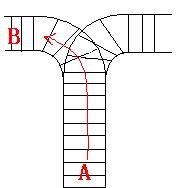HDU 1022 Train Problem I(栈的操作规则)
传送门:http://acm.hdu.edu.cn/showproblem.php?pid=1022
Train Problem I
Time Limit: 2000/1000 MS (Java/Others) Memory Limit: 65536/32768 K (Java/Others)
Total Submission(s): 45375 Accepted Submission(s): 16966
Problem Description
As the new term comes, the Ignatius Train Station is very busy nowadays. A lot of student want to get back to school by train(because the trains in the Ignatius Train Station is the fastest all over the world ^v^). But here comes a problem, there is only one railway where all the trains stop. So all the trains come in from one side and get out from the other side. For this problem, if train A gets into the railway first, and then train B gets into the railway before train A leaves, train A can't leave until train B leaves. The pictures below figure out the problem. Now the problem for you is, there are at most 9 trains in the station, all the trains has an ID(numbered from 1 to n), the trains get into the railway in an order O1, your task is to determine whether the trains can get out in an order O2.






Input
The input contains several test cases. Each test case consists of an integer, the number of trains, and two strings, the order of the trains come in:O1, and the order of the trains leave:O2. The input is terminated by the end of file. More details in the Sample Input.
Output
The output contains a string "No." if you can't exchange O2 to O1, or you should output a line contains "Yes.", and then output your way in exchanging the order(you should output "in" for a train getting into the railway, and "out" for a train getting out of the railway). Print a line contains "FINISH" after each test case. More details in the Sample Output.
Sample Input
3 123 321
3 123 312
Sample Output
Yes.
in
in
in
out
out
out
FINISH
No.
FINISH
For the first Sample Input, we let train 1 get in, then train 2 and train 3.
So now train 3 is at the top of the railway, so train 3 can leave first, then train 2 and train 1.
In the second Sample input, we should let train 3 leave first, so we have to let train 1 get in, then train 2 and train 3.
Now we can let train 3 leave.
But after that we can't let train 1 leave before train 2, because train 2 is at the top of the railway at the moment.
So we output "No.".
Hint
Hint
Author
Ignatius.L
Recommend
分析:
此题不真正的仔细读难理解出事栈的应用,容易想成反序相等就yes的问题,此题题意是说输入的两列字符串,第一列表示进入的顺序,第二列表示出去的顺序,问你是否符合后进先出。
举出一列数据 7 1234567 4321576
上面数据应该是 in in in in out out out out in out in in out out;
所以不是反序才行 可以进到一半就出的stl就是好用啊!
code:
#include<bits/stdc++.h> using namespace std; typedef long long LL; int main() { int n,i,j; string str1,str2; while(cin>>n>>str1>>str2) { stack<char> s; vector<string> v; for( i=0,j=0;i<n&&j<n;i++) { s.push(str1[i]);//元素进栈 v.push_back("in");//字符压进容器 while(s.top()==str2[j])//匹配 { if(!s.empty()) { s.pop(); v.push_back("out"); } j++; if(s.empty()) break; } } if(j==n)//判断依据 { printf("Yes.\n"); for(i=0;i<v.size();i++) cout<<v[i]<<endl; cout<<"FINISH"<<endl; }else { cout<<"No."<<endl<<"FINISH"<<endl; } } return 0; }
心之所向,素履以往
分类:
ACM




【推荐】国内首个AI IDE,深度理解中文开发场景,立即下载体验Trae
【推荐】编程新体验,更懂你的AI,立即体验豆包MarsCode编程助手
【推荐】抖音旗下AI助手豆包,你的智能百科全书,全免费不限次数
【推荐】轻量又高性能的 SSH 工具 IShell:AI 加持,快人一步
· SQL Server 2025 AI相关能力初探
· Linux系列:如何用 C#调用 C方法造成内存泄露
· AI与.NET技术实操系列(二):开始使用ML.NET
· 记一次.NET内存居高不下排查解决与启示
· 探究高空视频全景AR技术的实现原理
· 阿里最新开源QwQ-32B,效果媲美deepseek-r1满血版,部署成本又又又降低了!
· SQL Server 2025 AI相关能力初探
· AI编程工具终极对决:字节Trae VS Cursor,谁才是开发者新宠?
· 开源Multi-agent AI智能体框架aevatar.ai,欢迎大家贡献代码
· Manus重磅发布:全球首款通用AI代理技术深度解析与实战指南